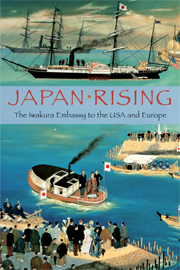Introduction by Ian Nish
Published online by Cambridge University Press: 04 August 2010
Summary
This is an introduction to the journey of the Iwakura Embassy which was sent out by the Japanese government in 1871. It was an ambitious journey round the globe and lasted for nineteen months. The chronicler of the Mission, Kume Kunitake, skilfully indicates both the wonderment of the visitors at what they saw and the hard-working intensity of their programmes. On the other side, it shows the open-heartedness of the countries visited whose citizens were ready to show off their wares and share their technology with their unfamiliar visitors from Japan.
Kume Kunitake (1839–1931) was chosen by Prince Iwakura as his secretary for the journey. Kume, a young Confucian scholar from a samurai background, was born in the domain of Saga in the island of Kyushu, not far from Nagasaki. That port was the access-point for foreign traders, whether from China, Korea or the Netherlands, in the days of Japan's seclusion from the rest of the world. Through his father's bureaucratic connections with trade, Kume would presumably have become acquainted with some of the ways of the non-Japanese world. His experiences by the age of thirty-two were such that he was neither bewildered nor star-struck by what he discovered as the Embassy travelled round the world's capitals and met the world's leaders. On the contrary he makes shrewd observations throughout. It was Kume's task to take notes and, on his return to Japan, to edit them for publication.
- Type
- Chapter
- Information
- Japan RisingThe Iwakura Embassy to the USA and Europe, pp. xi - xxixPublisher: Cambridge University PressPrint publication year: 2009



